Looking Without Fear
Portraying Appalachia
By Roger May
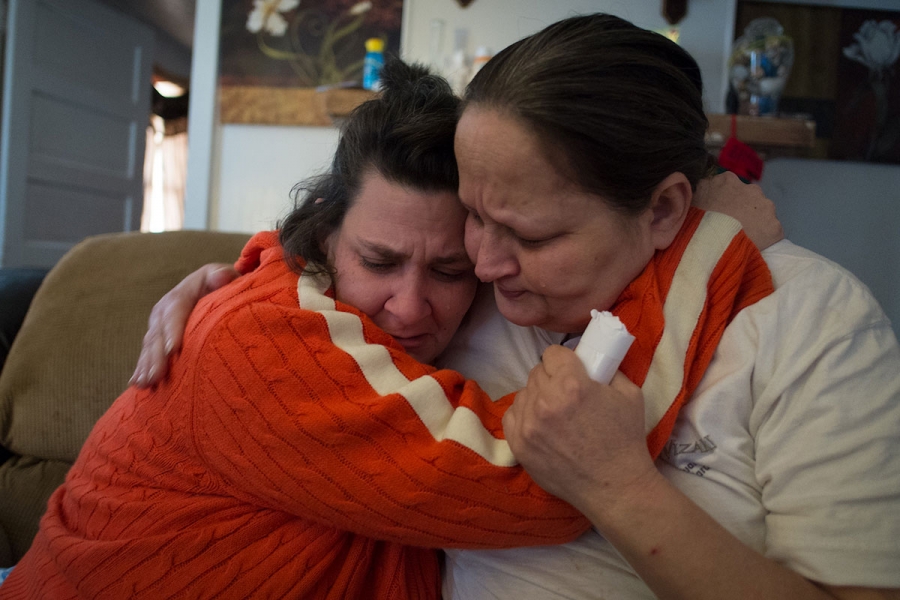
Neighbors Kim McDonald and Candi Elswick, console each other after voicing their fears about their children’s health in the aftermath of the Freedom Industries chemical leak in West Virginia. All photographs © Roger May
From “Portraying Appalachia,” a five-part symposium on representation and the region.
Recently, I was commissioned by the Guardian to photograph the aftermath of the chemical leak in Charleston, West Virginia. I should say up front that I’m not a breaking news photographer. I typically work with long form projects. The national media’s short attention span with disasters like this frustrates me, so I had intentionally avoided running to West Virginia when the incident occurred—there were far more capable local photographers covering the leak on the ground, because local news, grand or not, is their regular beat. But the editor who pitched me was interested in the human element of this story and how that could be communicated powerfully through photographs; it would be a compassionate assignment and I have a great personal stake in West Virginia. I packed my bags and headed out on that all-too-familiar stretch of highway that takes me home.
I spend a great deal of time looking at photographs of Appalachia. I’m interested in them all, and particularly in those made by photographers whose work hasn’t been widely circulated. One thing I’ve become sure of in the years that I’ve been intentional about my looking at Appalachia is that there is no definitive picture of the place. There is, however, no shortage of photographers making pictures in Appalachia. All of these collectively form a broad, complex, and imperfect visual representation of the region, its place and its people. I tend to characterize this as the greater visual dialogue of Appalachia, wherein we as photographers are adding our voices to the conversation through our pictures.
In looking at Appalachia—not just from the outside, but from within as well—we reveal more about ourselves as observers than the region objectively. The subjects show us shades of our own individuality. That’s not easy to unpack, or even admit to, but I think it is why some depictions of Appalachia make us uncomfortable. Ronald D. Eller, former director of the Appalachian Center, writes: “We know Appalachia exists because we need it to exist in order to define what we are not. It is the ‘other America’ because the very idea of Appalachia convinces us of the righteousness of our own lives. The notion of Appalachia as a separate place, a region set off from mainstream culture and history, has allowed us to distance ourselves from the uncomfortable dilemmas that the story of Appalachia raises about our own lives and about the larger society.” Perhaps, taking it a step further, the region, especially in its stereotypes, awakens our fear of self-recognition. We know what we are and what we’re not, but we’re uncomfortable, even afraid, of what someone assumes about us based on their visual predisposition. I would argue that these aren’t irrational fears, but they simply haven’t been talked about enough and healthy dialogue has yet to be fostered and maintained, so the common response, the easy response, is to wave the banner of “otherness” with white knuckles and eyes wide shut.
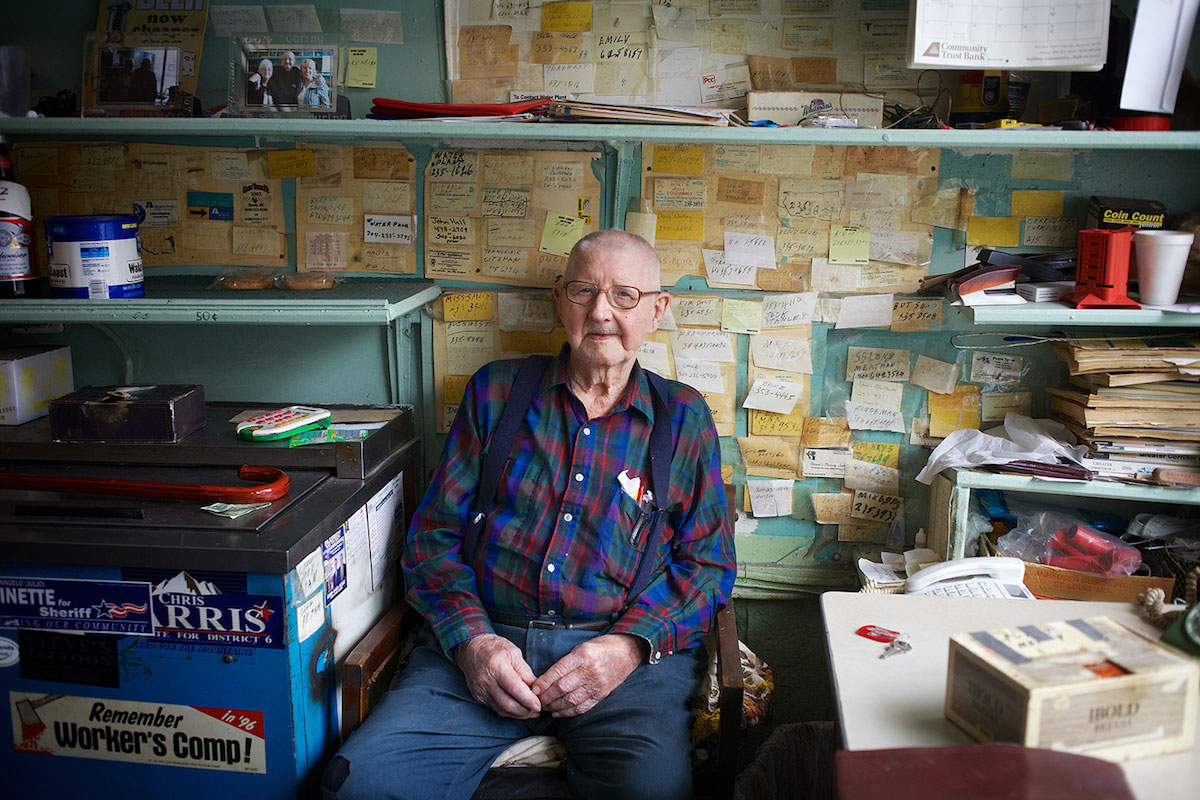
Mr. Tom Pecco Jr., 91 of Belfry, Kentucky, has worked at his store—Pecco’s Cary Out—in Williamson, West Virginia for 77 years. Through the great floods of ’57, ’63, ’77, and ’84, he's met every famous politician to visit Williamson, from JFK to Jay Rockefeller. Pecco says he’ll retire when he's too old to work.
Today, a greater danger lies in over-romanticizing Appalachia than showing photographs that offend or might possibly offend. Front porches, grandmothers in kitchens, American flags. Our expectations of photographs from Appalachia, about Appalachia, have to extend beyond these. Admittedly, I’ve made these pictures too, but that doesn’t change the fact that they’re cliché, boring, and don’t represent the complexity of such a broad region of America. We must move past the conviction that only Appalachians themselves can highlight the region’s poverty (or anything considered potentially embarrassing or shameful, for that matter). Poverty, hunger, and suffering exist, and the old War on Poverty images would have us believe that’s all that exists, but we know different. We grow tired of the systemic problems and assumptions that come from those types of images. Still, to intentionally avoid photographing these uncomfortable topics is to do an immeasurable disservice to not only Appalachia, but to America and beyond.
Some artists whose work concerns Appalachia are considerate of the long history of misrepresentation there, particularly with the long reach of social media today. I demand a great deal of myself when I make pictures in Appalachia for this reason. As I’m working through this sort of self-awareness and self-editing while in the field, I’m actively considering the final picture and its implications. Admittedly, this type of work causes me to miss moments or at times not be as present with the people and places I’m photographing as I’d like to be. I take great care to provide reference and circumstance for my pictures, but so often ostensibly controversial photographs aren’t considered in the context in which they were made. All of this can’t be translated to the viewer looking at the final picture—context can be very difficult in photography—and photographs are so often removed from their sources and considered on their own. Ultimately, the responsibility of the viewer lies in the recognition of the limitations of the medium and the subjective, not objective, perspective offered within the frame. An accurate documentary photograph—of Appalachia as of anyplace—must be honestly rendered and it must be honestly observed, understanding that both the maker and viewer bring their own biases and filters to the table.
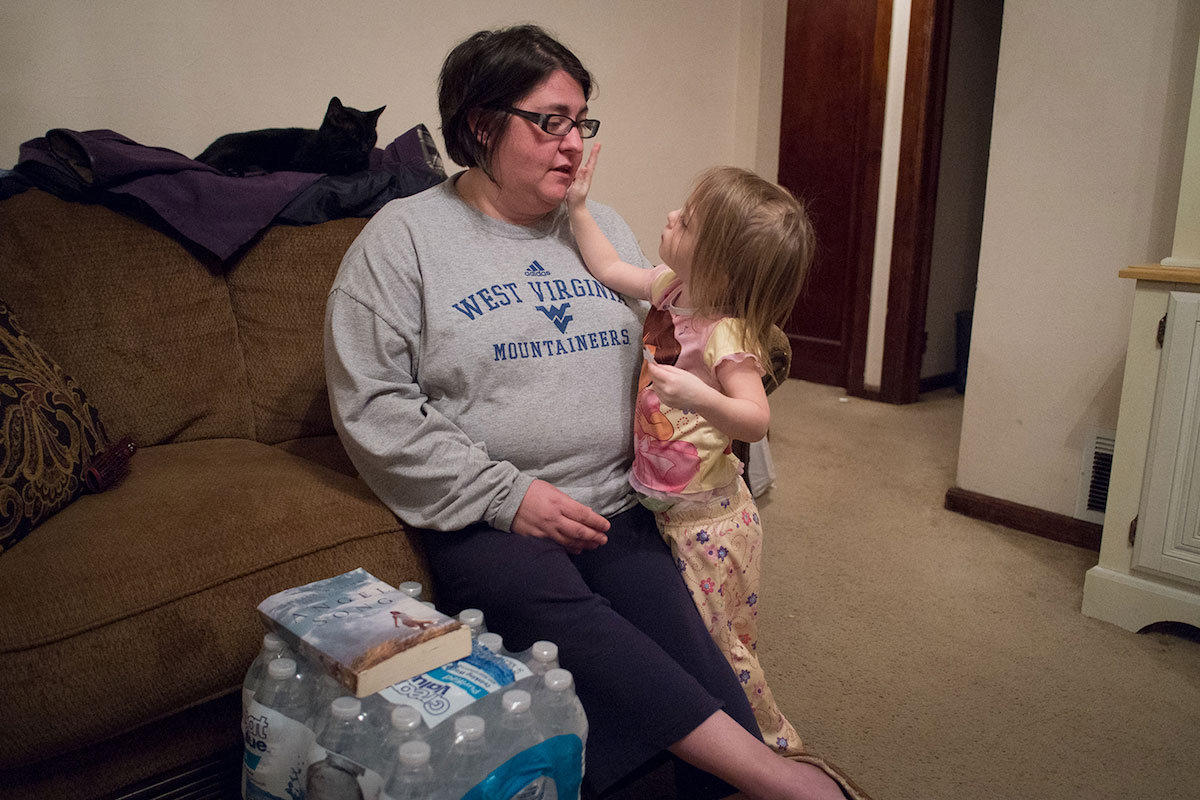
Andie Johnson and daughter Elie, Sissonville, West Virginia. Johnson, a third-grade elementary school teacher, talks about the fear of not knowing the long-term affects of the contaminated water. She and her husband, James, boiled snow so their youngest children Elie, 3, and Marlie, 2, could bathe. (First published in the Guardian.)
Time is the key thing for me. Prior to the Guardian assignment I made at least dozen trips to West Virginia last year, visiting folks who have allowed me into their lives to tell their stories. We have relationships. I have been working closely in the communities in and around home for roughly ten years. If you simply drop in to a region for a few days to make pictures, there’s a strong likelihood that, no matter how visually striking your images may be, you have missed out on the opportunity to connect with locals and foster any sort of relationship. And though your intentions can be the purest, what Appalachians have known for a long time is that people come in and they take. Timber, coal, natural gas, people, and pictures. I’ve decided that I’m not going to be another taker in a long line of takers. I am in Appalachia to make, which for me, means that I can’t make or create without the collaboration of the people and communities I’m photographing.
Many people invited me into their homes and lives during my brief coverage of the chemical leak in West Virginia. It was an incredibly emotional experience, one that I’ll admit I was woefully unprepared for. The scale and magnitude of the disaster’s impact on day-to-day life was hard to process. I spent a lot of time listening, being present, and trying to understand what it would be like for my family—spared, but just barely, down in Mingo County, West Virginia—to be in this situation. Looking back, I made very few pictures, but the ones I made and ultimately the ones the editors decided to feature, I hope expressed the toll taken on these people, families, and communities. All the while I knew that my few short days there was only a vignette into catastrophe.
Ultimately, I would rather not make a picture than run the risk of crossing someone I want to photograph, which is why I’d be a horrible news photographer. When my work is complete, I need to be able to look the person or people or community in the eye and have them be okay with the work we’ve done. Because of this, I’ve missed a lot of pictures, and will likely miss more.
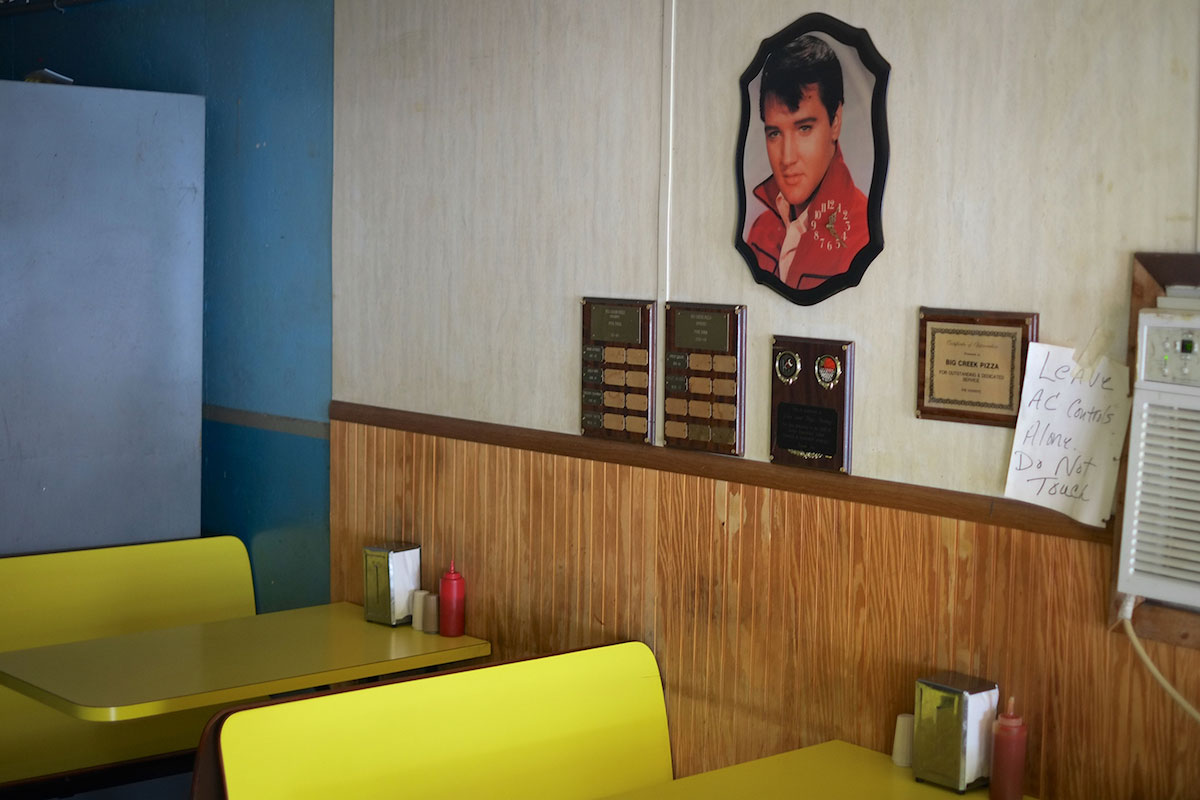
Big Creek Pizza, Pike County, Kentucky.
Recently, I was thinking about my grandfather and missing him a great deal. I decided to flip through his bible where, throughout the worn pages, he’d scribbled notes, passages, and sometimes prayer requests. Though I couldn’t find it, I remember the bookmark on which he’d written the word “fear” as an acronym; False Evidence Appearing Real.
I’ve heard that often our own shortcomings are easier seen in others. I think this can be applied to our fears, our discomfort about not only how others perceive us, but deeper still how we perceive ourselves.
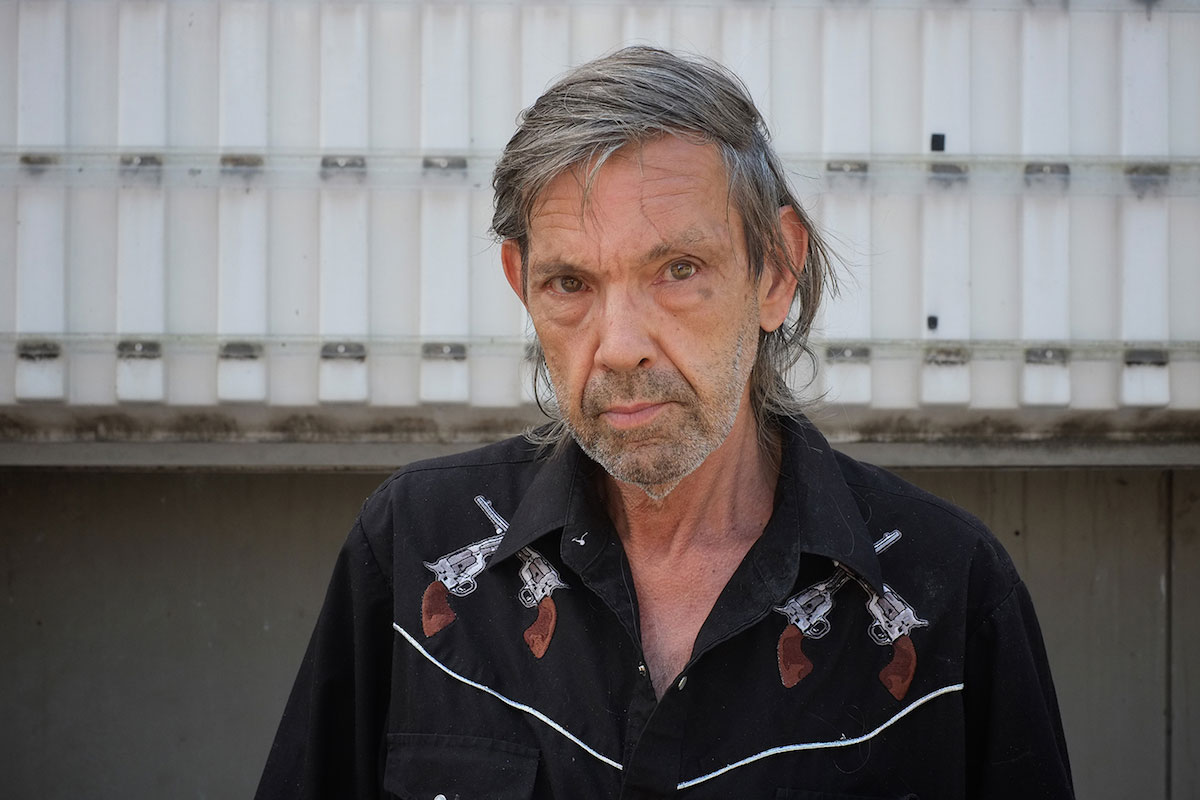
Charles Parker, Welch, West Virginia. He told me he had another shirt just like it, but instead of crossed pistols it had crossed guitars.


